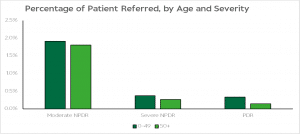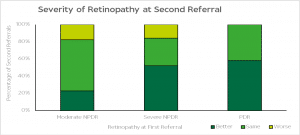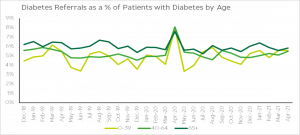As Australia marks National Diabetes Week from 11-17 July, Specsavers ANZ director of optometry DR BEN ASHBY outlines the latest trends in diabetic eyecare and how the company is spotting opportunities to enhance its approach.
People living with diabetes are at risk of experiencing changes to their eyes over their lifetime, including potentially sight-threatening diabetic retinopathy (DR). Of an estimated 1.7 million Australians with diabetes, approximately 25-35% are likely to experience some form of DR – meaning potentially 600,000 Australians are at risk of preventable vision loss.

Early detection and treatment are key to preventing DR vision loss. A prime motivation of the KeepSight program is to increase awareness among people with diabetes of the need for regular eye checks, to ensure any retinopathy is detected early.
Specsavers Australia and New Zealand director of optometry Dr Ben Ashby says the company is reducing vision loss in people with diabetes by improving timely detection of DR and access to the collaborative eyecare ecosystem, while also using its own data to shed light on patient care within that ecosystem.
With two years of significant data following the journeys of patients with diabetes, Specsavers can identify trends in patient care, estimate the prevalence of DR among its patients, and identify opportunities to enhance care.
Prevalence of people with diabetes
Since reporting started in December 2018, 6.4% of all patients seen at Specsavers have diabetes, aligning with currently reported national prevalence rates. Its data also supports government reporting which states the self- reported prevalence of diabetes is higher for males (8.4% of male patients seen at Specsavers) than females (5%).
Since 2018, 5.5% of patients with diabetes have been referred for specialist management. Of these, 14% had retinopathy classified as minimal (64% of these patients had another referrable condition, such as glaucoma or cataract, at time of referral), 35% (2% of all patients with diabetes) as mild-moderate, 8% (0.4% of all patients with diabetes) as severe and 5% (0.3% of all patients with diabetes) as proliferative DR.
This breakdown follows reported relative frequencies of the different levels of DR among patients with diabetes. Interestingly, there is little difference in retinopathy prevalence between patients under 50, and those over 50, though proliferative retinopathy appears slightly more common in younger patients.
In comparison with epidemiological studies, Ashby states that data based on optometric referrals will likely always give lower estimates for retinopathy. In line with the RANZCO referral pathway for DR, many patients with less severe retinopathy will be managed by optometrists. These patients will hence not appear in referral data, potentially skewing these numbers lower.

In addition, in the past two years, 12.6% of patients referred for diabetic eye disease were referred more than once, with an average 364 days between referrals. Of these patients, 50% were referred with the same level of retinopathy, and 30% were referred with more severe retinopathy.
Concerningly, 16% of these patients initially referred with severe non- proliferative diabetic retinopathy (NPDR) were referred again with proliferative retinopathy. Ashby says this speaks to the need for a collaborative approach to diabetic eyecare, ensuring patients with diabetes are reviewed regularly, even after referral, and referred again should the need arise.

Ashby adds that it’s interesting to note a defined “spike” in referrals during national COVID-19 restrictions last April.
“This can largely be attributed to a shift in the type of care provided during this time. While the total volume of patients with diabetes reduced during this period, the percentage of patients with diabetes presenting was relatively stable,” he says.
“The likely inference is that patients at lower risk of retinopathy deferred appointments during this time, skewing attendances towards patients with urgent needs or more severe DR, who are more likely to require referral.”
While Ashby says it’s positive to see a significant percentage of patients presenting with DR referred within appropriate timeframes, more work is required to ensure every Australian with diabetes accesses regular eyecare.

Diabetes Australia CEO Professor Greg Johnson says diabetes management is time consuming and can be challenging for some people with the disease.
“Diabetes is a complex condition and people with diabetes need to have a range of regular health checks and tests to manage their condition. This can place major demands on people’s time and sometimes things get overlooked or put off,” he says.
“There are also many people with diabetes who are not aware they need to have their eyes checked. KeepSight is all about making it easier for people to book their regular eye checks. Once a person is registered with KeepSight they receive reminders and prompts when they are due for a check. It’s that simple.”
More reading
Shifting the dial on diabetes-related blindness




